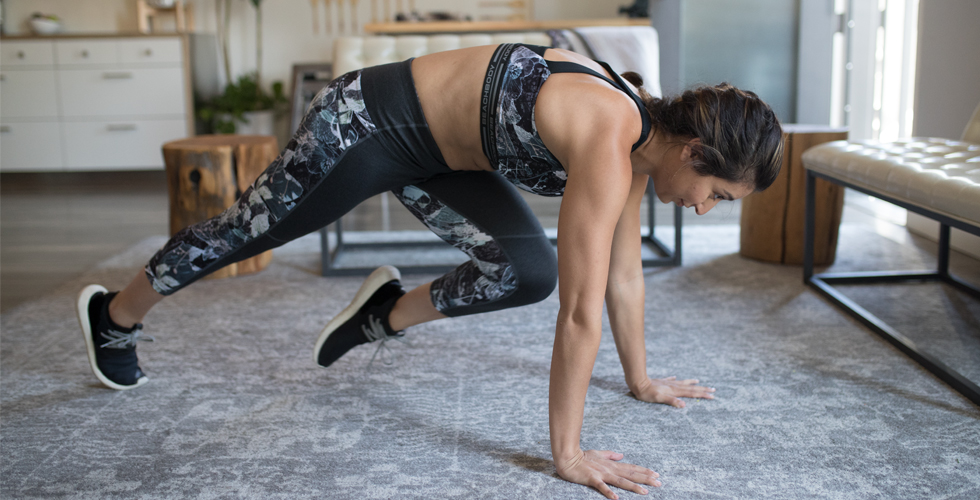Climbing is one of the most challenging, all-over strengthening exercises you can do. But you don’t need to defy gravity to work your entire body at once. That’s the idea behind the mountain climbers exercise.
Performed from a high-plank position, mountain climbers build strength and stability through the core, shoulders, triceps, quads, and even glutes. Plus, they do all of that while revving your heart rate and improving your cardiovascular health.
To reap the full benefits of mountain climbers, though, you need to do more than simply go through the motions. You need to learn how to generate total-body tension and activate the right muscles. Here, learn how to perform this classic exercise — and several awesome variations — with perfect form.
Mountain Climbers Exercise: Step-by-Step Instructions
Program: TOUGH MUDDER T-MINUS 30
Workout: Sheriff Abs
- Assume a push-up position: feet together, core braced, body straight from head to heels, hands in line with and slightly wider than your shoulders.
- Lift your right foot off the floor and draw your right knee toward your chest, making sure to keep your back flat, your butt down, and the rest of your body stationary. Tap the floor with your toes.
- Return your right foot to the starting position, and immediately repeat with the opposite leg. That’s one rep.
- Continue alternating legs, performing equal reps on both sides.
10 Mountain Climber Variations
Using the classic mountain climbers exercise as a base, you can expand its possibilities to target specific muscle groups or intensify calorie burn.
1. Foot-switch mountain climber
After tapping the toes of your right foot to the floor, simultaneously return it to the starting position and bring your right knee forward. Continue alternating legs in a “running-like” motion.
2. Standing mountain climber
If holding a plank gives you wrist or low-back pain, perform the move from a standing position. Draw one knee up toward your chest while reaching for the ceiling with your opposite hand. Return to the starting (standing) position, and repeat with your opposite hand and leg. Continue alternating sides.
3. Mountain climber push-up
Regular mountain climbers too easy? Do a push-up between reps of the mountain climber (remember, one rep equals bringing each knee toward your chest once). Or do two reps followed by two push-ups — or whatever other configuration you like.
4. Mountain climber donkey kick
Increase glute recruitment during the mountain climbers exercise by kicking both heels up toward the ceiling between reps.
5. Semicircle mountain climber
Instead of “running” in place, you’ll “run” while swiveling around on your hands, moving from side to side in a semicircle on the floor.
6. Spider climber
Swing your knees out sideways toward your elbows rather than toward your chest to emphasize your obliques and adductors.
7. Incline mountain climber
If you find the classic mountain climber too difficult to perform with proper form, elevate your hands on a step, box, bench, or other stable surface. The greater the angle of your body to the floor, the easier the exercise becomes.
8. Decline mountain climber
To increase load on your arms and shoulders, perform the move with your feet elevated on a stable surface, such as a step or low box.
9. Renegade mountain climber
Gripping a dumbbell in each hand, alternately row each weight to the side of your torso between reps of the mountain climber.
10. Cross climber
Draw each knee to the opposite elbow to improve rotational strength and work your obliques.
What Are the Benefits of the Mountain Climbers Exercise?
While most people perform mountain climbers as a way to strengthen the core, it’s important to remember that they also build strength in the shoulders, arms, and legs. And because they involve continuous movement of so many muscle groups, they also challenge (and strengthen) your cardiovascular system.
What muscles do mountain climbers work?
- Core (transverse abdominis, rectus abdominis, obliques, latissimus dorsi, glutes): Your abdominals, obliques, and lats help stabilize your body and minimize spinal movement while your glutes (yes, they’re a core muscle) extend your hips.
- Shoulders (deltoids): Although their primary function is to help move your arms, the job of your shoulders during the mountain climber is to help lock them into place.
- Arms (triceps): Keeping your arms straight in a high plank position is the job of your triceps.
- Legs (hip flexors, hamstrings, quadriceps): As you bring your knee toward your chest, your hip flexors and hamstrings engage to flex your hip and knee joints. Afterward, your quads and glutes take over to extend those joints.
Are mountain climbers a good ab workout?
It’s hard to think of a core muscle that the mountain climber doesn’t hit, making it one of the best “abs” exercises you can do. And as the variations above illustrate, slight modifications to how you perform the mountain climber can zero in on specific core muscles. But the two primary ones that you’re working are your transverse abdominis and rectus abdominis.
Holding a plank and maintaining a strong, stable torso trains your transverse abdominis, which works like a corset or weight belt to stabilize your spine. Meanwhile, with each “climb,” your rectus abdominis, or “six-pack” muscles, drive the movement.
Do mountain climbers burn belly fat?
While mountain climbers get your heart rate up and are an efficient way to burn calories with zero equipment and minimal space, you need to perform them as part of a comprehensive exercise routine in order to shed fat.
It’s also important to remember that while mountain climbers can strengthen and create definition in your abs, you can’t “spot reduce” fat in that area. But as you lose overall body fat, your abs will be revealed.
The post How to Do Mountain Climbers for a Stronger… Well, Everything appeared first on BODi.


0 Comments